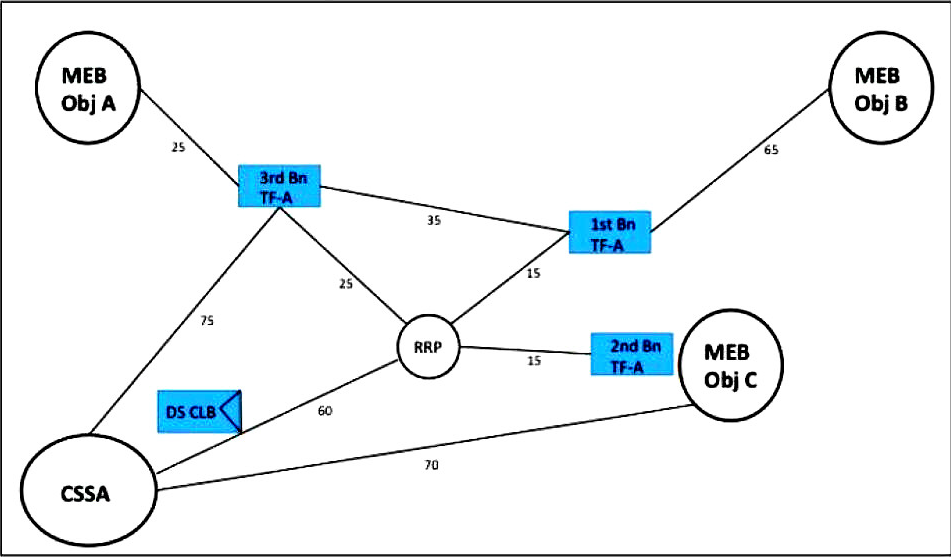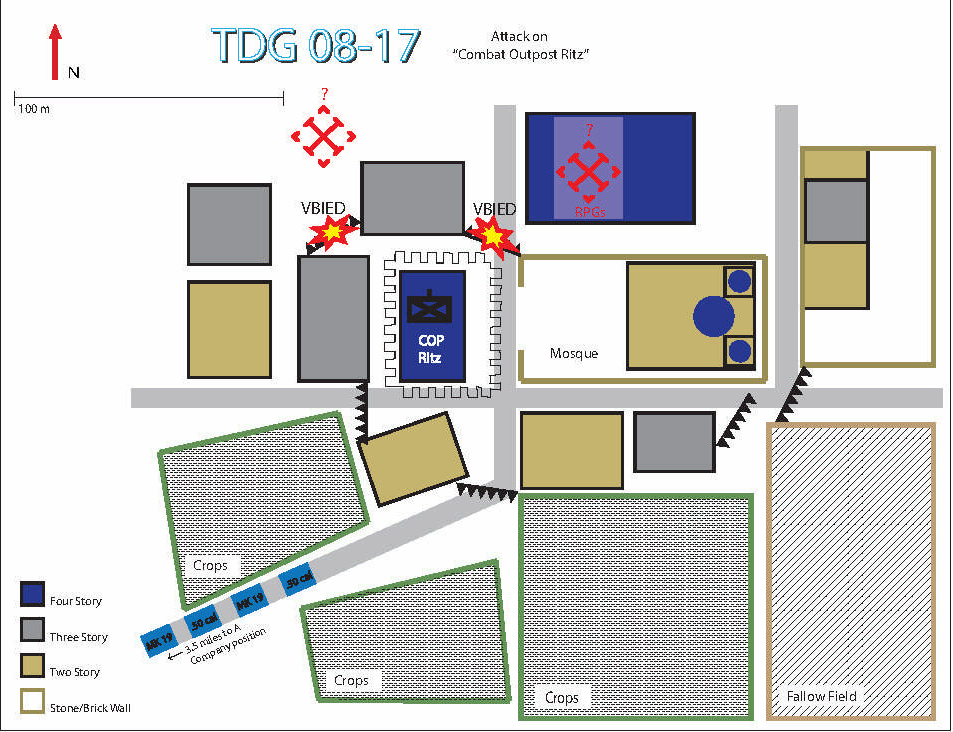by Maj John F. Schmitt, USMCR
Marines are coming to recognize the value of tactical decision games (TDGs) as a tool for teaching better decisionmaking. The key to a valuable learning experience is a well-designed scenario, one that poses a challenging problem and describes a realistically complex and uncertain tactical situation in clear, concise terms. I have learned the hard way that as simple as the games appear-after all, they are nothing more than a sketch map and a couple paragraphs of textthey can be surprisingly difficult to design. Based on having written over 30 TDGs for the Gazette, I offer the following suggestions for designing effective TDGs.
The TDG as a Story
Think of the TDG as a short action story-like something out of a Tom Clancy or Harold Coyle novel or, even better, out of one of the Horatio Hornblower novels by C.S. Forester. Set the stage, introduce the characters (in this case friendly and enemy units), add more and more events and information (some of it confusing), and build to a suspenseful climax. But instead of telling how the story turns out, stop right at the climactic moment and require the player to finish the story. Make the player describe how the protagonist (i.e., commander) gets out of the predicament you put him in. As with an action story, the idea is to create a tense and risky situation requiring resolution, one that illustrates some significant tactical concept, technique, or insight.
A Picture Is Worth a Thousand Words
I draw a sketch of the scenario before I try to write the text. People tend to think in terms of images rather than in text, and I find that the scenario develops in my mind faster and more clearly when I work from a drawing rather than from a written description. I try to fill in as much of the detail as possible before I start writing: I fill in the terrain and vegetation; I place friendly and enemy forces on the map; I work out scale, time-distance factors, and spatial relationships, capturing as much of the situation as possible on the map. Only then do I start to write, and the written scenario is a simple matter of describing what already exists on the map.
Format of the TDG
When it comes to writing the scenario, I generally use the following format:
* Start by telling the players who they are so that when they read or hear the scenario they know what point of view to take. Then tell them what assets they have. For example: “You are the commander of Company B, 1st Battalion, 5th Marines. In addition to your organic assets, you have a Dragon section and a tank platoon attached.”
* Next, describe the general situation: the terrain, weather, time of day, type of enemy, overall mission and intent of friendly forces, etc. It is helpful to provide a general orientation so the player can quickly get his or her bearings, e.g., “The enemy is generally attacking from east to west.”
* Describe from general to specific. For example, if the TDG is a battalion problem, describe the division’s situation, then the regiment’s, then the battalion’s. Describe the general enemy capabilities and activities, then describe specific enemy units.
* As specific events occur, describe them chronologically. The last thing you describe should be the event that puts the finishing touches on the dilemma. It should be the trigger event-the thing which makes it clear that a decision must be made.
Types of TDGs
From a design perspective, there are two basic types of TDGs:
* “Here’s your mission.” You provide the situational factors including enemy size, disposition, and activities; own dispositions; terrain; weather; etc. You assign a basic mission, like attack or defense. The object of the game is for the player to come up with a plan to accomplish the mission. This is the simpler type of TDG and it can be valuable for exercising the ability to estimate the situation or understand the tactical implications of terrain. The second TDG ever to appear in the Gazette, TDG #90-2 “Attack on Knob Hill” (May90), is a good example of this type of scenario. In that simple scenario, the player was a platoon commander assigned the mission of attacking Knob Hill in order to destroy an enemy force there.
* “Now what?” In this type of TDG, the scenario provides all of the above, plus more. Picking up where the former type of TDG leaves off, the scenario explains that as you begin to execute your plan some unforeseen event occurs that changes the whole scenario. The object now becomes to react to the new situation in a way that is consistent with the higher commander’s intent. One way to create a “Now what?” TDG is to create a “Here’s your mission” TDG, solve it yourself, and then create a new problem by having something go wrong with the execution of the solution. The first TDG ever to appear in the Gazette, TDG #90-1 “Enemy Over the Bridge” (Apr90), is a good example of this type of scenario. In that scenario, the player was a battalion commander ordered to move into an assembly area in preparation for an attack across a river the following morning. But as the scenario develops the player learns that a sizable enemy force occupies his assembly area and that the friendly forces supposedly holding the bridge are nowhere to be found.
Potential Sources for TDGs
* History. Pick one of your favorite battles involving one of your favorite commanders. The Harper Encyclopedia of Military History by R. Ernest and Trevor Dupuy is a good place to go for ideas. Military atlases are also helpful. Modernize the weapons and organization. Adjust the scale if necessary (in general, dispersion and engagement ranges have increased through history). Caveat: Don’t fall into the trap of thinking that the way the battle turned out historically is the “right” solution. Making only a few “minor” changeslike modernizing weapons-can alter the whole dynamic of the problem.
* Own experiences in exercises or operations. The above caveat applies. Even minor changes to the scenario may change the original situation in fundamental ways, so don’t get hooked on actual results. For example, TDG #94-3 “Picket Duty” (Mar94) was based on an actual experience, but in drawing it up I unintentionally changed the terrain in a way that altered the whole problem.
* Create a dilemma; start out with a basic problem. For example: “How would you react if you were engaged with a large enemy force to your front and another appeared on the flank?” Then fill in the situational factors: terrain, vegetation, size and type of units, etc.
Start with a basic mission. For example: “What sorts of situations is a company acting as the advance guard for a movement to contact likely to encounter?” Again, fill in the situational factors. (This can be an especially useful technique for working through contingencies or immediate-action drills in preparation for an upcoming mission.)
* Random engagement. Start with any piece of terrain, real or imaginary, and throw the forces in randomly. Have the enemy force appear from one or more directions and have the friendly force appear from another. Or have one of the forces stationary. Assign plausible missions to both sides (but don’t tell the player what the enemy’s mission is) and fill in the other situational factors.
Fog and Friction
Clausewitz said that friction distinguishes real war from war on paper. In order to be good, a TDG must be realistic. In order to be realistic, it must have fog and friction built into it.
The TDG should have a healthy dose of uncertainty. Don’t give the player perfect intelligence. There are two basic \vays to create uncertainty. The first is through a lack of information. Just leave some of it out. For example, you get a report of contact, but you don’t know the size or type of the enemy force. The second is through ambiguity-making some information unclear, inconclusive, or even contradictory. (A technique I sometimes use is to have the map and text disagree slightly.) Either way, the results are the same. The player \vill have to make certain assumptions in order to develop an estimate of the situation based on incomplete information.
The TDG should incorporate friction in the form of things not going as planned or expected. A good TDG should usually provide a good example of Murphy’s Law at work-units get lost or show up late (or early), communication breaks down, the enemy does something unexpected, etc.
Characteristics of a Good TDG
In addition to fog and friction, a good TDG exhibits these qualities:
* Interesting. This is the most important quality. Like a good action story, the TDG should get the reader engrossed in the dilemma. The best TDGs cause a momentary sense of dread, as the player thinks: “How do I get out of this one?”
* Challenging. The TDG should pose a significant predicament. It should force a tough decision. This is not the same thing as merely creating a situation in which the player faces overwhelming odds. A squad coming face to face with an enemy division might be in a tough situation, but the decision of what to do-get out of there-is probably pretty obvious. In a good TDG, the decision should be challenging.
* Plausible. The players ought to recognize that the situation could realistically happen, or else the game will lack credibility. This is not to say that situations should only be “doctrinal,” predictable, or probable. War is full of nondoctrinal, unforeseeable, and improbable events. The key is to make those events believable. Time and space factors must be reasonable and relate realistically to conditions of weather, terrain, and visibility.
* Proper amount of detail. The scenario should have enough information for the players to act but not so much information that the game becomes unrealistic or laborious. If the player has to spend too much time and effort just getting read into the situation, he will lose interest. The trick is to describe a difficult situation in simple terms. A good rule of thumb for length is two double-spaced pages.
* Proper type of detail. This means that the information provided should relate to the level of the game. For example, a squad TDG requires a map with microterrain (folds in the ground, small clumps of woods, fences, individual buildings, etc.) and a scale in hundreds of meters (or less). By comparison, a division TDG should show main avenues of approach, major obstacles and major geographical features (ridge lines, rivers, urban areas, etc.), and should have a scale in tens of kilometers or more. For a battalion TDG, show companies and battalion-level attachments on the map. These are the “moving pieces” that concern the battalion commander. For a platoon TDG, show squads, etc.
* Allowance for multiple interpretations and solutions. Normally there should not be only one reasonable way to solve the TDG. There may be one proper course to take, but there should be several possible ways to go about it. The idea is to give players a chance to exercise creativity. This also means that the map should have enough surrounding terrain for “outside the box” solutions. If the map is too narrowly bounded it may restrict players’ options.
* A reasonable time limit. A strict time limit for coming up with a solution is an important way of introducing an element of stress to the exercise. But the imposed time limit should be consistent with the scenario. For example, these is no reason to require a solution in 5 minutes when according to the scenario the operation will not commence for several hours. Ideally, the time limit should come right out of the scenario. For example, the enemy advance guard will crest a hill in about 10 minutes and discover our entire battalion, and so the player has less than that much time to make a decision. (Using the half-rule, 5 minutes would be a good time limit in this case.)
* Accuracy. TDGs (and particularly solutions) should reflect accurate knowledge offeree structure, weapons characteristics, and weapons employment concepts.
Start With a Problem, Not With a Solution
It is usually better to start with a question or problem and to allow the players to create solutions than it is to start \vith a specific solution and to work backwards to create a scenario to support it. In the latter case, the scenario usually turns out to be obvious and contrivedalmost like a leading question for which there is one obvious “right” answer.
Other Design Hints
* Reverse scenarios. After you have designed a TDG, create another one by using the same scenario from the enemy point of view. I have found that this technique can be extremely useful in getting players to try to “get inside the enemy’s head.”
* Tilt the terrain. Use the same basic scenario, but tilt the map 90 degrees and see how the dynamics of the scenario change.
* Continuations. After you have designed a TDG, take one solution and apply it to the scenario to create the next problem: “Okay, you started to execute your plan and then this happened. Now what do you do?” Sometimes it can be instructional to play out a battle through several moves.
* Change some variables. Try changing the scenario from daylight to darkness, from foot infantry to mech, from desert to forest. Change the enemy force from a platoon to a company. Change some of the time-distance factors and see how that changes the dynamics of the problem.
* Special operations. Special operations, like hostage rescues, etc., generally require a lot of very detailed planning information and are consequently difficult to design. This is not to say that it can’t be done; it usually requires a more detailed scenario (and can run the risk of becoming difficult for the player to get into). The same is true to a lesser extent for any deliberate operation. In my experience, TDGs are best suited for hasty situations. For deliberate situations, a conventional planning exercise may be better.
* TDGs seem to work best from the platoon to the battalion level. At lower levels, scenarios and maps tend to require much more detail. (In fact, at the small-unit level a map view may not even be appropriate at all. Since small-unit leaders often do not use maps, a panoramic view of the terrain seen from ground level may be more appropriate-but harder to do.) At higher levels, decision cycles tend to be longer and the scenario often must describe a situation developing over a longer period of time with more factors to consider. Again, this is not to say that TDGs below platoon level and above battalion level will not work; they may just require a little more care in setting up the scenario properly.
Conclusion
There are many ways to design a good TDG-probably as many techniques as there are designers. The best approach I can suggest is trial and errorjust take a crack at it and figure out what works. In my experience it won’t be time wasted. The thought process in trying to design a TDG is as valuable a learning experience as playing one.
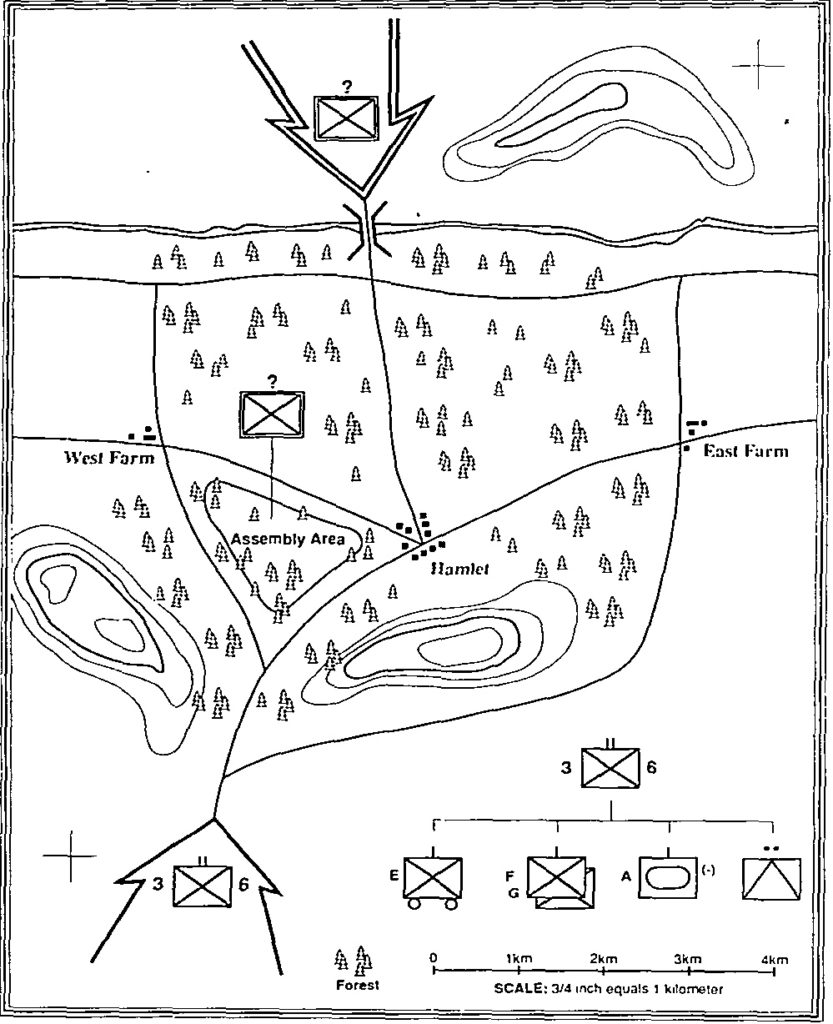 You are the commanding officer, 3d Battalion, 6th Marines. Your battalion consists of two rifle companies on foot, one rifle company in trucks, a tank company (minus), and a TOW section on HMMWVs.
You are the commanding officer, 3d Battalion, 6th Marines. Your battalion consists of two rifle companies on foot, one rifle company in trucks, a tank company (minus), and a TOW section on HMMWVs.



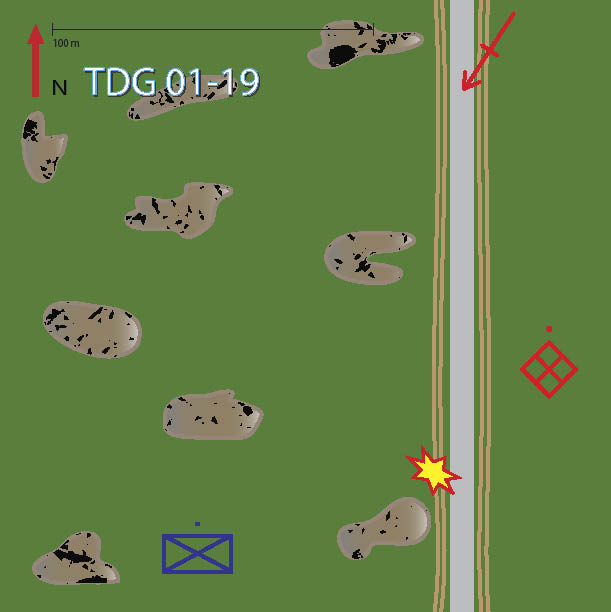


 You are the CO, 1st Bn, 6th Marines, 4th Marine Brigade, 2d Infantry Division, American Expeditionary Forces. Your battalion is currently located to the southeast of Lucy-de-Bocage. During the Battle of Château-Thierry on 6 June 1918, the 4th Marine Brigade seized Hill 142 and the town of Bouresches and established a foothold in the southern portion of Belleau Wood. The clearing of Belleau Wood is now essential in preventing harassing fire and in ensuring the overall security of the Paris-Metz highway—the main Allied line of communication. With outcropping boulders, dense foliage, and steep, rolling terrain, Belleau Wood offers the perfect defensive position and is currently occupied by the German Army with elements of the 461st Infantry Regiment, 237th Division in the north and the 40th Fusiliers Regiment, 28th Division in the south. Operations conducted by Marines from 6 through 9 June have shown that the Germans are armed with heavy and light machine guns and are well supported with artillery fires. German artillery units have been known to utilize chemical munitions. The enemy has regimental-sized elements to the north and east of Belleau Wood that can make a movement to reinforce during the night.
You are the CO, 1st Bn, 6th Marines, 4th Marine Brigade, 2d Infantry Division, American Expeditionary Forces. Your battalion is currently located to the southeast of Lucy-de-Bocage. During the Battle of Château-Thierry on 6 June 1918, the 4th Marine Brigade seized Hill 142 and the town of Bouresches and established a foothold in the southern portion of Belleau Wood. The clearing of Belleau Wood is now essential in preventing harassing fire and in ensuring the overall security of the Paris-Metz highway—the main Allied line of communication. With outcropping boulders, dense foliage, and steep, rolling terrain, Belleau Wood offers the perfect defensive position and is currently occupied by the German Army with elements of the 461st Infantry Regiment, 237th Division in the north and the 40th Fusiliers Regiment, 28th Division in the south. Operations conducted by Marines from 6 through 9 June have shown that the Germans are armed with heavy and light machine guns and are well supported with artillery fires. German artillery units have been known to utilize chemical munitions. The enemy has regimental-sized elements to the north and east of Belleau Wood that can make a movement to reinforce during the night.
 You are the commander of the 4th Marine Brigade, 2nd U.S. Division. It is early on 9 June 1918. Your mission, assigned by the commander of the 2nd Division, is to “clear Belleau Wood on 11 June 1918.” This is a matter of particular importance to higher echelons of command, as the majority of the American public thinks that the Marines have already cleared Belleau Wood.
You are the commander of the 4th Marine Brigade, 2nd U.S. Division. It is early on 9 June 1918. Your mission, assigned by the commander of the 2nd Division, is to “clear Belleau Wood on 11 June 1918.” This is a matter of particular importance to higher echelons of command, as the majority of the American public thinks that the Marines have already cleared Belleau Wood.
 You are the platoon commander of Second Platoon, A Company, 1st Battalion, 1st Marines. Since your 3d squad is conducting a day security patrol, the remainder of your reinforced platoon is currently “standing by” on a plus-fifteen-minute alert as the Company’s quick reaction force (QRF). This means your company commander expects you be able to depart friendly lines with your force in fifteen minutes or less from the time support is requested.
You are the platoon commander of Second Platoon, A Company, 1st Battalion, 1st Marines. Since your 3d squad is conducting a day security patrol, the remainder of your reinforced platoon is currently “standing by” on a plus-fifteen-minute alert as the Company’s quick reaction force (QRF). This means your company commander expects you be able to depart friendly lines with your force in fifteen minutes or less from the time support is requested.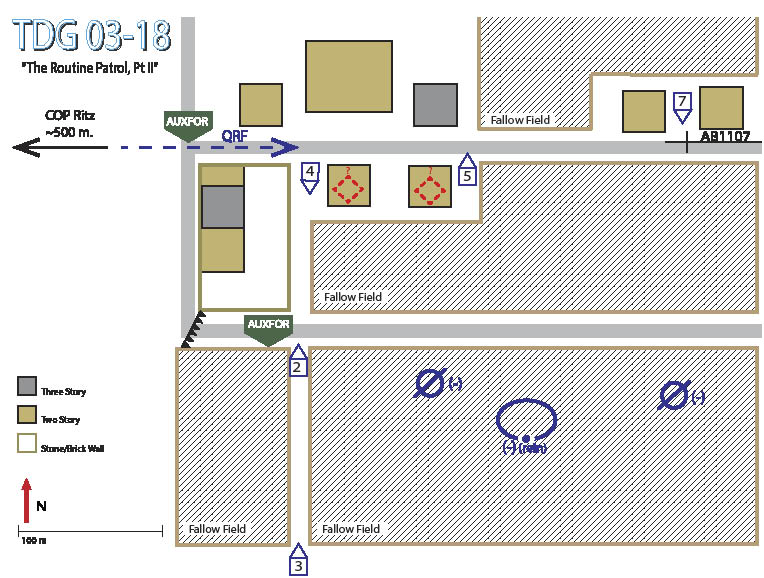
 You are the squad leader of 3d Squad, 2d Platoon, A Company, 1st Battalion, 1st Marines. You have been leading a day security patrol east of the company positon at COP Ritz past the Al Mumeet Mosque and southeast of several abandoned farms and fields thickly overgrown with shoulder-high sawgrass and upland cane.
You are the squad leader of 3d Squad, 2d Platoon, A Company, 1st Battalion, 1st Marines. You have been leading a day security patrol east of the company positon at COP Ritz past the Al Mumeet Mosque and southeast of several abandoned farms and fields thickly overgrown with shoulder-high sawgrass and upland cane.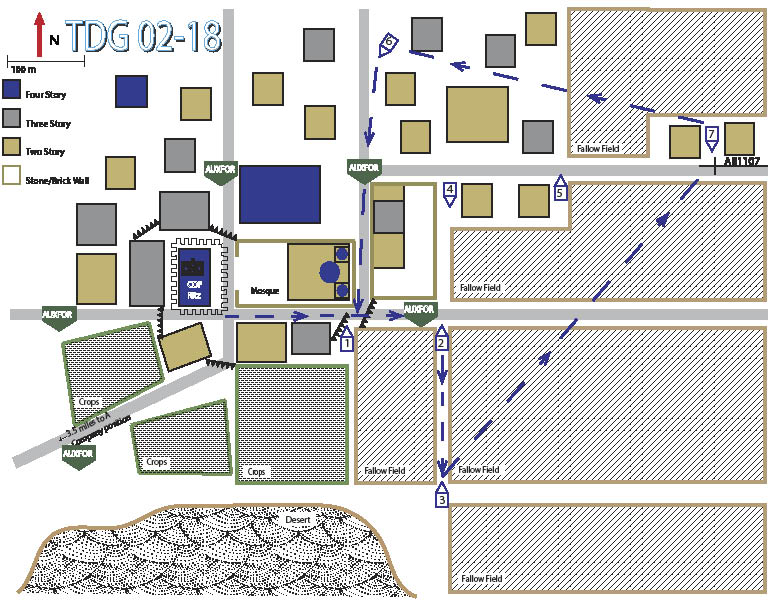
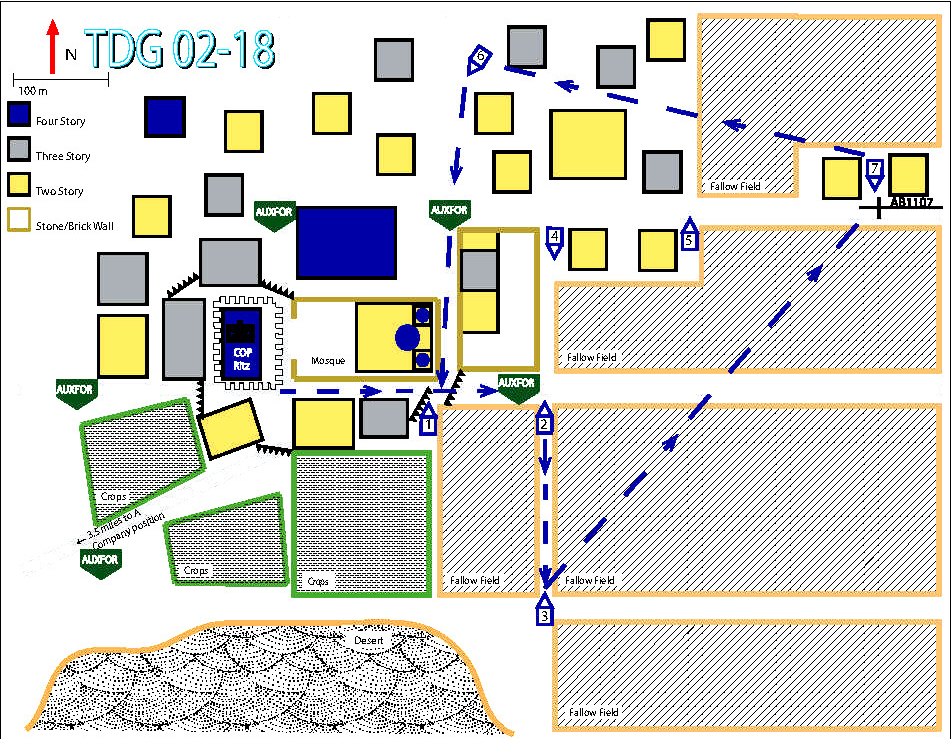 You are the squad leader of 3d Squad, 2d Platoon, A Company, 1st Battalion, 1st Marines. Your squad has been ordered to conduct a day security patrol east of the company position at COP (combat outpost) Ritz. Your designated patrol route (depicted on Figure 1) will take you out past the Al Mumeet Mosque and southeast to the far side of several abandoned farms and fields thickly overgrown with shoulder-high sawgrass and upland cane. You and your Marines have been on patrol both day and night, approximately every 48 to 72 hours, ever since the company occupied COP Ritz. You and your team leaders are highly experienced in patrolling the congested area surrounding the COP and have been in more firefights than you can remember. On several occasions, you have had to call in the Company’s quick reaction force (QRF) to reinforce your patrol after making contact.
You are the squad leader of 3d Squad, 2d Platoon, A Company, 1st Battalion, 1st Marines. Your squad has been ordered to conduct a day security patrol east of the company position at COP (combat outpost) Ritz. Your designated patrol route (depicted on Figure 1) will take you out past the Al Mumeet Mosque and southeast to the far side of several abandoned farms and fields thickly overgrown with shoulder-high sawgrass and upland cane. You and your Marines have been on patrol both day and night, approximately every 48 to 72 hours, ever since the company occupied COP Ritz. You and your team leaders are highly experienced in patrolling the congested area surrounding the COP and have been in more firefights than you can remember. On several occasions, you have had to call in the Company’s quick reaction force (QRF) to reinforce your patrol after making contact.
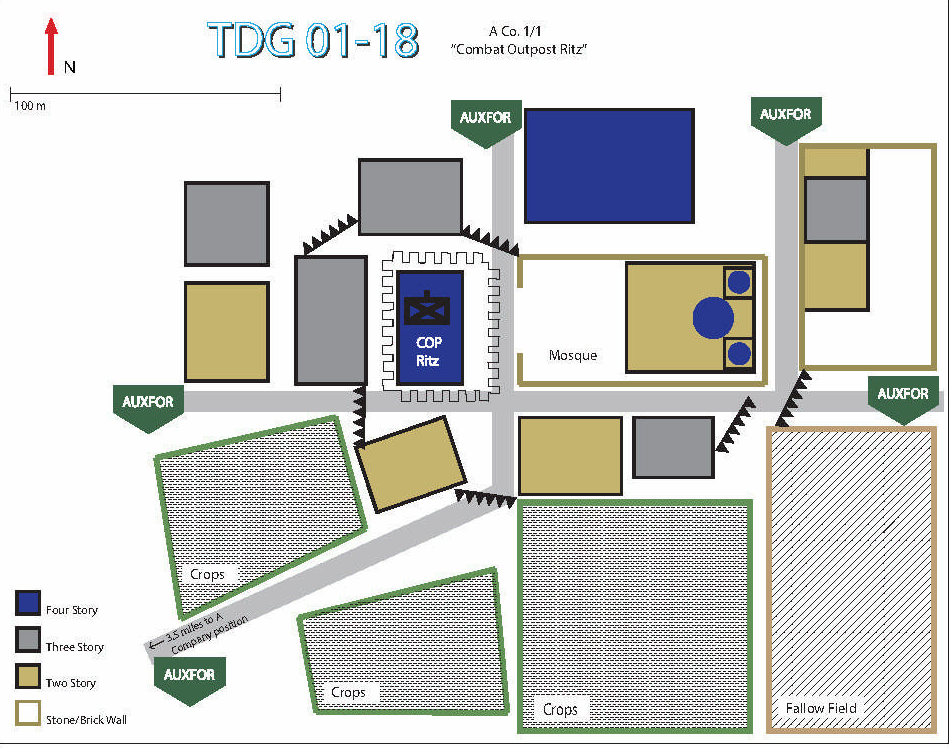 It has been 30 days since the U.S. Mission in Al Ouadiyya and the CJTF officially partnered with the Nuzuri tribe and contracted their militia as “auxiliary forces,” or AUXFOR (pronounced “oxford” by your Marines), for the security and stability mission on the island nation. You remain the Company Commander, A Company, 1st Bn, 1st Mar, and despite a non-punitive letter of caution from your battalion commander for exaggerated reporting of enemy forces in the midst of an attack on your COP (combat outpost), you are beginning to think you may stay in command of “Red Death” for the roughly two months remaining in this deployment … if you live that long.
It has been 30 days since the U.S. Mission in Al Ouadiyya and the CJTF officially partnered with the Nuzuri tribe and contracted their militia as “auxiliary forces,” or AUXFOR (pronounced “oxford” by your Marines), for the security and stability mission on the island nation. You remain the Company Commander, A Company, 1st Bn, 1st Mar, and despite a non-punitive letter of caution from your battalion commander for exaggerated reporting of enemy forces in the midst of an attack on your COP (combat outpost), you are beginning to think you may stay in command of “Red Death” for the roughly two months remaining in this deployment … if you live that long.